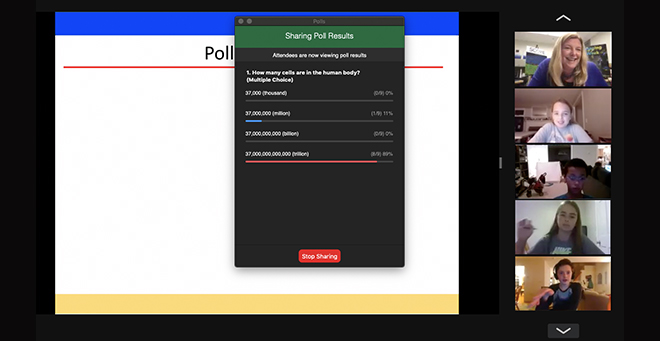Interactive virtual ScienceLIVE program builds in Worcester schools
The science program for middle school students is presented by UMass Medical School researchers
An interactive online science program for middle school students developed and presented by UMass Medical School researchers will deepen its partnership with Worcester Public Schools this fall, according to organizers.

ScienceLIVE (Learning with Interactive Virtual Education) team members say the Zoom modules by scientists from diverse backgrounds will help foster development of a life science workforce that includes people from traditionally underrepresented gender, racial and ethnic groups.
ScienceLIVE was launched last year by the RNA Therapeutics Institute, Department of Microbiology & Physiological Systems and Sanderson Center for Optical Experimentation (SCOPE) in partnership with Technocopia Inc., a nonprofit community makerspace in downtown Worcester, as an outreach program for students in Worcester-area schools or home schools. The aim was to foster educational opportunities by creating a program in which diverse graduate students and postdoctoral fellows facilitate exciting, hands-on activities for middle school students (ages 10-13), all designed for virtual teaching during the COVID-19 pandemic.
Modules were presented to homeschooled students last fall as a pilot; but in spring, more than 1,800 Worcester seventh- and eighth-grade students, from four of the district’s six middle schools, participated, said Angela Messmer-Blust, PhD, assistant professor of RNA therapeutics and senior scientific advisor in the RNA Therapeutics Institute, who coordinates outreach for ScienceLIVE.
Mary Pickering, PhD’06, senior scientist in the lab of Nicholas Rhind, PhD, professor of biochemistry & molecular pharmacology, trained approximately 25 graduate students and fellows to teach the roughly 80 presentations.
“One hundred percent of the teachers who were surveyed following their classes’ involvement said that the students showed an increase in questions and excitement about learning about STEM (science, technology, engineering and mathematics),” Dr. Pickering said. “And all of the teachers said that they would participate in ScienceLIVE in the future.”
The team has been thinking about ways to make the program more experiential, Pickering said, with hands-on experiments and activities that could be done either alongside the presentations or as follow-up activities. They also want to reinforce the school district’s curriculum and make it easy to customize for classrooms.
Worcester students in spring took part in modules covering DNA, including the definition of life, what constitutes cells and DNA extraction; antibiotic resistance and evolutionary biology mutations; and bioinformatics and evolutionary biology, in which students used a free computer program by the National Institutes of Health, called Basic Local Alignment Search Tool, to compare DNA sequences.
“I really enjoyed seeing the kids come alive seeing the science and get really excited by the research,” said Dr. Messmer-Blust. “One of the students had their 23andMe genetic testing done. He began asking questions about comparing his genome to another animal’s genome, and it was thrilling to see the light bulbs go off.”
She said, “We found that making sure that we have content that is relevant to their lives has been super important.”
Messmer-Blust added that organizers hope to interest these students in UMass Medical School’s Pipeline recruitment programs as they continue through school.
“Our motivation starting out was to help the local teachers and the local students,” said Christina Baer, PhD, assistant professor of microbiology & physiological systems and director of SCOPE. “It’s grown into a program that has a number of different goals, which I think will be mutually beneficial for the UMass Medical School community in terms of participation and developing science communications. And one of the reasons that we want to get in on the ground level with these kids and get them excited and inspired about science is that they are the future of the UMass workforce.”
It is not only middle-school students who are getting inspired.
Athma Pai, PhD, assistant professor of RNA therapeutics, said, “It is really beneficial for the graduate students who are already at UMass, who are already scientists but are exploring career options. I think there is a lot of interest in teaching, which they might not have as many opportunities to do on a day-to-day basis.”
ScienceLIVE is also supported by funding from UMass Medical School Office of Community and Government Relations, the Department of Microbiology & Physiological Systems, the RNA Therapeutics Institute, the Program in Systems Biology, and a grant from Boston Scientific Foundation.